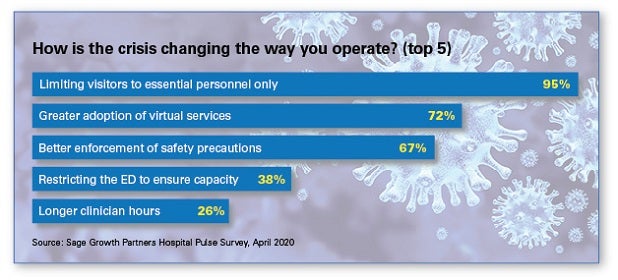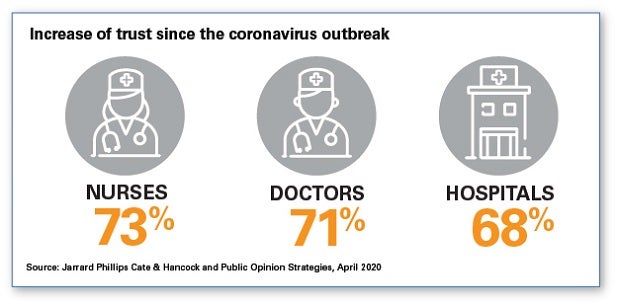

Confronting Coronavirus: What to Focus on as You Prepare to Resume Services
Prepare for a New Reality as You Resume Services
As the focus of health care providers and consumers shifts to the next chapter of the COVID-19 pandemic — a phased approach to reopening society — hospitals and health systems face new realities.
As time moves on, the need for safe medical care not related to COVID-19 becomes more important than ever for the communities that hospitals and health systems serve. Hospitals and health systems will need to communicate both internally and externally about how plans and procedures have changed, while underscoring that the field is able to protect the healthy and at the same time care for the sick and injured.
However, the rapid spread of the virus has made some fearful about returning to health care facilities and left them uncertain about when it will be safe to do so, especially when tens of millions of consumers have seen a change in their employment status due to the outbreak, and large numbers have lost their health insurance.
Alternative care models like telehealth have gained ground in these last few months, leading to substantive and perhaps permanent changes in patients’ perceptions about the safest and most affordable ways to initially access care. And in one of the more positive developments for hospitals and health systems as they communicate with the public about their plans to resume nonemergent surgeries and other services, trust in providers has risen sharply.
A recent consumer survey, conducted by the Nashville-based health care communications consulting firm Jarrard Phillips Cate & Hancock in concert with Public Opinion Strategies, illustrates these trends. Among the survey’s findings:
- 45% of respondents said they or someone in their household had a change in employment status due to COVID-19. Of this group, 26% had lost their health insurance.
- Most respondents (54%) believe COVID-19 is the most important issue facing the country, and three out of four — regardless of where they lived or whether they had a chronic condition — said they are worried about the pandemic.
- 51% rated their feelings of safety in a health care facility as 5 or lower on a 10-point scale, with women noticeably less confident than men.
![]()
“Fear is driving patients’ decisions to seek medical care,” says David Jarrard, president and CEO of the firm that bears his name, in summing up the results. Hospital and health system leaders will need to focus on their strategic messaging to patients during this transition period and leverage the high trust that physicians, nurses and hospitals have earned since the pandemic began, he notes.
Nurses, physicians and hospitals held the survey’s top three favorability rankings, with 85% or more of the respondents viewing them as very favorable or somewhat favorable during the pandemic.

Jarrard urges health care leaders to talk with physicians to be sure they feel secure and that they will be supported, and to carefully craft messages about staff and patient safety and the safety of the health care environment. Be specific, he says, and use data whenever possible to communicate what’s being done to keep health care workers, patients and others safe.
Transparency also is vital when communicating with patients who have suffered job losses, reductions in salary or loss of health insurance. Jarrard encourages provider organizations to be direct in discussing costs, payment terms and when financial assistance can be offered.
And, finally, be prepared for the new reality of patients’ willingness to engage in virtual care, home-based care and other forms of remote treatment and monitoring. Twenty-nine percent of respondents said they have used telehealth for a medical exam or consultation and 89% of that group were satisfied with the experience.
How COVID-19 Is Changing Hospital Operations
As hospitals adapt to the influx of COVID-19 patients, providers are changing how and where they interact with patients and their families. Health care facilities are adding intensive care-unit beds and converting outpatient facilities to handle inpatient care. Health care supply chain executives are dealing with shortages and increasing demands for supplies of personal protective equipment, ventilators, respirators and critical medicines. In response to the crisis, many health system leaders are focusing on hospital operations.
Top Operational Impacts
According to recent research by Sage Growth Partners, C-suite executives from 138 U.S. hospitals and health systems said they are: limiting visitors to essential personnel only (95%); increasing adoption of virtual services (72%); enhancing enforcement of safety precautions (67%); restricting use of the emergency department (ED) to ensure capacity (67%); and increasing clinicians’ working hours (26%). Telehealth is being used in conjunction with call centers to reduce the burden on the ED and lessen the overall flow of patients across all lower-acuity care settings to protect patients and providers. Given the significant changes to operations, frequent and transparent internal communication helps employees understand the steps the organization is taking to protect them and their families as well as coordinate safety measures for patients and the community.

Key Technology Solutions
When asked to identify key technology solutions that seem more critical during the COVID-19 crisis, two-thirds of the health care executives indicated providing access to virtual care. Similarly, executives found more importance in technologies to improve hospital communication (49%) in light of major changes to hospital operations and supply chain analytics (49%) to track and allocate resources. Tools to address clinical surveillance and infection prevention and workforce management also were key technologies.
The broader availability of telehealth has increased interest in digital health solutions. And, other research by Sage Growth Partners on “Evolving U.S. Healthcare Needs and Attitudes During COVID-19” showed that consumers want their providers to offer more telehealth visits as an option to office visits after the COVID-19 crisis subsides. Expect investments in information technologies that improve the effective coordination and delivery of care and supply chain analytics to allocate resources to patients and providers. Health care technologies have enabled organizations to function during the pandemic and will continue to reshape health care in the future.

Today, health care executives rank ensuring patient safety as the most concerning functional priority on their minds, followed by human capital/workforce management, supply chain, loss of revenue from canceled services and overall financial stability. Executives are considering the changing dynamics of health care operations during COVID-19 and its long-term ramifications.
The AHA COVID-19 website has the latest tools and resources to help hospitals and health systems respond to the pandemic.
We want to hear from you! Please send your feedback to Bob Kehoe at rkehoe@aha.org.




